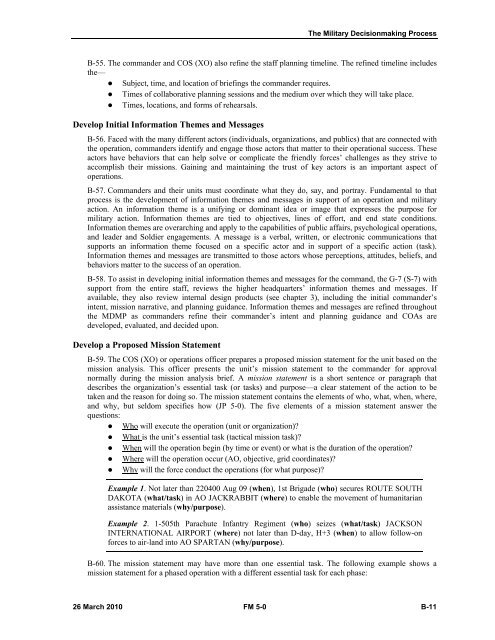FM 5-0, The Operations Process - Federation of American Scientists
FM 5-0, The Operations Process - Federation of American Scientists
FM 5-0, The Operations Process - Federation of American Scientists
You also want an ePaper? Increase the reach of your titles
YUMPU automatically turns print PDFs into web optimized ePapers that Google loves.
<strong>The</strong> Military Decisionmaking <strong>Process</strong><br />
B-55. <strong>The</strong> commander and COS (XO) also refine the staff planning timeline. <strong>The</strong> refined timeline includes<br />
the—<br />
• Subject, time, and location <strong>of</strong> briefings the commander requires.<br />
• Times <strong>of</strong> collaborative planning sessions and the medium over which they will take place.<br />
• Times, locations, and forms <strong>of</strong> rehearsals.<br />
Develop Initial Information <strong>The</strong>mes and Messages<br />
B-56. Faced with the many different actors (individuals, organizations, and publics) that are connected with<br />
the operation, commanders identify and engage those actors that matter to their operational success. <strong>The</strong>se<br />
actors have behaviors that can help solve or complicate the friendly forces’ challenges as they strive to<br />
accomplish their missions. Gaining and maintaining the trust <strong>of</strong> key actors is an important aspect <strong>of</strong><br />
operations.<br />
B-57. Commanders and their units must coordinate what they do, say, and portray. Fundamental to that<br />
process is the development <strong>of</strong> information themes and messages in support <strong>of</strong> an operation and military<br />
action. An information theme is a unifying or dominant idea or image that expresses the purpose for<br />
military action. Information themes are tied to objectives, lines <strong>of</strong> effort, and end state conditions.<br />
Information themes are overarching and apply to the capabilities <strong>of</strong> public affairs, psychological operations,<br />
and leader and Soldier engagements. A message is a verbal, written, or electronic communications that<br />
supports an information theme focused on a specific actor and in support <strong>of</strong> a specific action (task).<br />
Information themes and messages are transmitted to those actors whose perceptions, attitudes, beliefs, and<br />
behaviors matter to the success <strong>of</strong> an operation.<br />
B-58. To assist in developing initial information themes and messages for the command, the G-7 (S-7) with<br />
support from the entire staff, reviews the higher headquarters’ information themes and messages. If<br />
available, they also review internal design products (see chapter 3), including the initial commander’s<br />
intent, mission narrative, and planning guidance. Information themes and messages are refined throughout<br />
the MDMP as commanders refine their commander’s intent and planning guidance and COAs are<br />
developed, evaluated, and decided upon.<br />
Develop a Proposed Mission Statement<br />
B-59. <strong>The</strong> COS (XO) or operations <strong>of</strong>ficer prepares a proposed mission statement for the unit based on the<br />
mission analysis. This <strong>of</strong>ficer presents the unit’s mission statement to the commander for approval<br />
normally during the mission analysis brief. A mission statement is a short sentence or paragraph that<br />
describes the organization’s essential task (or tasks) and purpose—a clear statement <strong>of</strong> the action to be<br />
taken and the reason for doing so. <strong>The</strong> mission statement contains the elements <strong>of</strong> who, what, when, where,<br />
and why, but seldom specifies how (JP 5-0). <strong>The</strong> five elements <strong>of</strong> a mission statement answer the<br />
questions:<br />
• Who will execute the operation (unit or organization)?<br />
• What is the unit’s essential task (tactical mission task)?<br />
• When will the operation begin (by time or event) or what is the duration <strong>of</strong> the operation?<br />
• Where will the operation occur (AO, objective, grid coordinates)?<br />
• Why will the force conduct the operations (for what purpose)?<br />
Example 1. Not later than 220400 Aug 09 (when), 1st Brigade (who) secures ROUTE SOUTH<br />
DAKOTA (what/task) in AO JACKRABBIT (where) to enable the movement <strong>of</strong> humanitarian<br />
assistance materials (why/purpose).<br />
Example 2. 1-505th Parachute Infantry Regiment (who) seizes (what/task) JACKSON<br />
INTERNATIONAL AIRPORT (where) not later than D-day, H+3 (when) to allow follow-on<br />
forces to air-land into AO SPARTAN (why/purpose).<br />
B-60. <strong>The</strong> mission statement may have more than one essential task. <strong>The</strong> following example shows a<br />
mission statement for a phased operation with a different essential task for each phase:<br />
26 March 2010 <strong>FM</strong> 5-0 B-11















